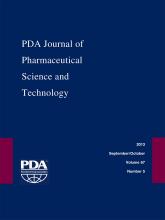Abstract
In 2006, the Product Quality Research Institute's (PQRI) Leachables and Extractables Working Group released a comprehensive and detailed recommendation document related to leachables and extractables for inhalation drug products. The document includes best pharmaceutical development practice recommendations regarding container closure/delivery system component composition and selection, controlled extraction studies, drug product leachables studies, and routine extractables testing for component release. Also included in the document are two safety-based thresholds for leachables in inhalation drug products, the qualification threshold (QT) and the safety concern threshold (SCT), the first such safety-based thresholds for leachables in any drug product type. A process was described for converting the SCT into an analytically useful threshold for leachables/extractables characterization, the analytical evaluation threshold (AET), with consideration of individual drug product dosing parameters and container closure system component characteristics.
This commentary presents the history and evolution of this recommendation document starting from the propellant changeover (chlorofluorocarbons to hydrofluorocarbons) in metered dose inhaler drug products, which helped prompt interest in inhalation drug product leachables, through the work process of the PQRI group. The overall positive acceptance of the PQRI recommendations is discussed, along with a brief summary of regulatory initiatives influenced by the recommendations. Also presented and discussed are certain key issues and questions that have arisen since the recommendation document was released. The extension and application of best practice recommendations to other high risk drug product types (e.g., large and small volume parenterals, ophthalmics), led by the PQRI Parenteral and Ophthalmic Drug Product Working Group, is introduced and considered.
LAY ABSTRACT: The recommendation document released by the Product Quality Research Institute's (PQRI) Leachables and Extractables Working Group in 2006 includes the first safety-based thresholds for leachables in any drug product type, along with comprehensive best practice recommendations for inhalation drug product pharmaceutical development related to extractables and leachables. The best practice recommendations encompass a number of important functional areas, including container closure/delivery system component composition and selection, controlled extraction studies, drug product leachables studies, and routine extractables testing for component release. This commentary presents the history and evolution of this recommendation document starting from the propellant changeover (chlorofluorocarbons to hydrofluorocarbons) in metered dose inhaler drug products, which helped prompt interest in inhalation drug product leachables, through the work process of the PQRI group. The overall positive acceptance of the PQRI recommendations is discussed, along with a brief summary of regulatory initiatives influenced by the recommendations. Also presented and discussed are certain key issues and questions that have arisen since the recommendation document was released. The extension and application of best practice recommendations to other drug product types (e.g., large- and small-volume parenterals, ophthalmics), led by the PQRI Parenteral and Ophthalmic Drug Product Working Group, is introduced and considered.
- Extractables
- Leachables
- Inhalation
- OINDP
- PQRI
- Qualification threshold
- Safety concern threshold
- Analytical evaluation threshold
- © PDA, Inc. 2013
PDA members receive access to all articles published in the current year and previous volume year. Institutional subscribers received access to all content. Log in below to receive access to this article if you are either of these.
If you are neither or you are a PDA member trying to access an article outside of your membership license, then you must purchase access to this article (below). If you do not have a username or password for JPST, you will be required to create an account prior to purchasing.
Full issue PDFs are for PDA members only.
Note to pda.org users
The PDA and PDA bookstore websites (www.pda.org and www.pda.org/bookstore) are separate websites from the PDA JPST website. When you first join PDA, your initial UserID and Password are sent to HighWirePress to create your PDA JPST account. Subsequent UserrID and Password changes required at the PDA websites will not pass on to PDA JPST and vice versa. If you forget your PDA JPST UserID and/or Password, you can request help to retrieve UserID and reset Password below.







Commentary